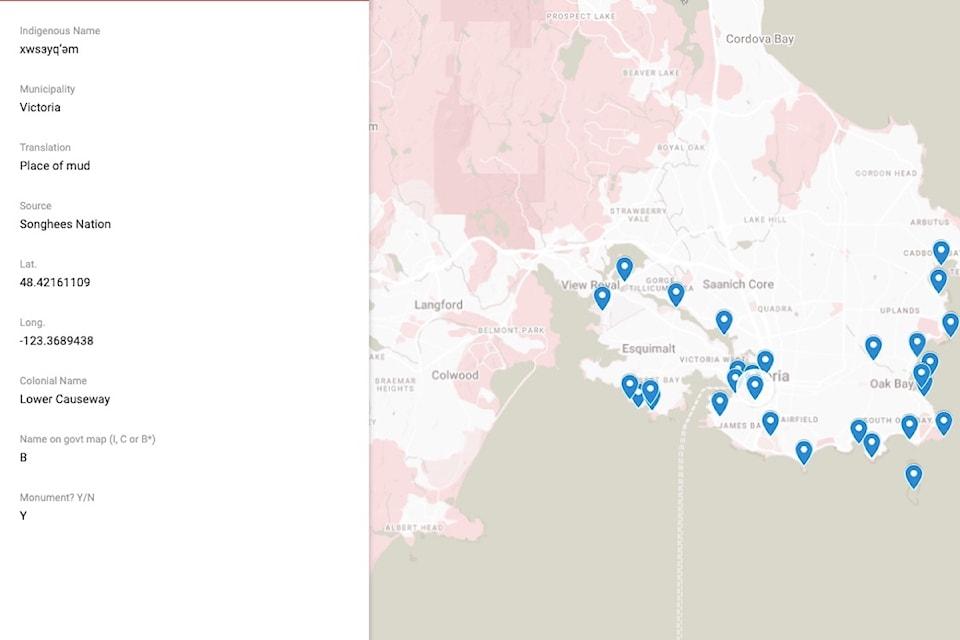Melinda Quintero honoured for map of First Nations heritage sites
Topics
Featured
Share online

Learn more about the Master of Arts in Tourism Management program.
When Royal Roads University Master of Arts in Tourism Management student Melinda Quintero first moved to Greater Victoria from the US, she wanted to explore its many landmarks. But her thoughts kept returning to the first inhabitants of these Lands – The Lekwungen-speaking Peoples, the Esquimalt and Songhees Nations.
Landmark thesis earns prestigious award
When she searched for more information about Indigenous place names and landmarks, she noticed the information was scattered and hard to find. This search inspired Quintero’s thesis First Nations Place Names from Cadboro Bay to Millstream, which earned her the Governor General’s Gold Medal at Convocation this fall.
The medal is awarded to the graduate-level student with the most outstanding dissertation, thesis, or graduate research project.
“When I got the news, I had to read the email a few times—I could hardly believe it,” says Quintero. “To me, this award acknowledges how place names play a major role in our long history of colonization and our current work with Truth and Reconciliation.”
“Receiving the award is incredibly encouraging, showing me that the research is pointed in the right direction, with far-reaching applicability. It is a tremendous honour to receive the Governor General’s Gold Medal. My project started with a small, simple idea and grew into a substantial piece of scholarship representing the care and work of countless First Nations knowledge keepers, artists, and community members. I’m looking forward to how the research will evolve with this encouragement from Royal Roads University.”
Mapping lək̓ʷəŋən place names
The result of Quintero’s research is a database mapping over 100 landmarks with their traditional lək̓ʷəŋən or SENĆOŦEN place name – all of cultural significance to the Esquimalt and Songhees First Nations, and the W̱SÁNEĆ Peoples.
“Tourism has this unique ability to tell stories,” Quintero says. “But the stories we’ve told in the past have often excluded Indigenous voices. Place names are a way to amplify those voices.”
Her thesis explores the power of First Nations place names to spark meaningful truth and reconciliation within the tourism industry. By mapping lək̓ʷəŋən names onto Victoria’s landmarks, Quintero aims to challenge the colonial narratives that shape many local tourism experiences.

Melinda Quintero's map shows over 100 Indigenous place names between Cadboro Bay and Millstream. Courtesy of Melinda Quintero
Preserving language and culture through storytelling
A significant feature of her work is consultation with Indigenous scholars and First Nations. Quintero worked with her thesis committee member and Chair of the Emerging Indigenous Scholars Circle Dr. Shauneen Pete to carefully and respectfully build these local connections.
Quintero’s research defers to the many Indigenous scholars and academics in the region who are documenting their languages through connections to their own Knowledge Keepers and language speakers. To compliment this Indigenous research, as a settler, Quintero relies on publicly available sources, such as monuments, Indigenous websites, and academic publications.
Bridging tourism and reconciliation
“This project gathers what’s already in the public sphere, showing settlers how much is out there,” she explained. “It’s about reciprocity—building awareness of what already exists in the settler landscape to encourage respect and awareness for Indigenous history and language.”
Through her research, Quintero demonstrates that tourism can be more than sightseeing—it can be a bridge to understanding. “It’s about connection,” Quintero said. “When you understand the names, you begin to understand the stories. And that changes how you see the world.”
Quintero will be honoured as part of the Royal Roads University 2025 Fall Convocation ceremonies.